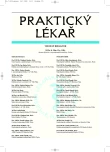-
Medical journals
- Career
Fractures that are hard to diagnose in the skeleton of a child
Authors: P. Havránek; T. Pešl; P. Vlček
Authors‘ workplace: Přednosta: prof. MUDr. Petr Havránek, CSc. ; 3. lékařská fakulta a FTNsP, Praha ; Klinika dětské chirurgie a traumatologie ; Univerzita Karlova v Praze
Published in: Prakt. Lék. 2008; 88(7): 403-407
Category: Diagnostis
Overview
Fractures in children differ from those in adults for many reasons. Besides general differences (such as body height and weight, neuro-psychological maturity of the patient and aetiology of the trauma), an important role can be seen in the biomechanical character of child bone and above all in the nature of bone growth. The anatomical appearance of growth plates at both ends of long bones (femur, tibia, humerus, radius and ulna) but at just one end of short tubular bones (metacarpals, metatarsals and phallanges) is a fundamental fact that distinguishes the adult bone from the pediatric. This particular presence of bone growth from growth plates (physes) is the reason that paediatric skeletal traumatology should be considered a subspecialization of paediatric surgery or trauma surgery or orthopaedic surgery. Another specific characteristic of the premature skeleton in children is incomplete ossification in periarticular bone regions. This is obvious in babies and small children. Thus, articular fractures and fractures-separations of the epiphyses in fully cartilaginous tissue cannot be detected by roentgenological investigation. Although a simplification, four defined fracture types can be distinguished in the immature skeleton of a child that are impossible to find in adults. Using numerous criteria for general classification of fractures (fracture line, fragment displacement, open fractures, overuse injury) it is possible to add these pediatric fractures to the classification of fractures according to fracture line shape (transverse, oblique, spiral, comminuted, impacted, etc.). These paediatric fractures are: 1. subperiosteal „torus, buckle“ fracture; 2. bowing fracture („plastic deformation“); 3. greenstick fracture and 4. physeal injury.
Key words:
physeal injury, torus fracture, greenstick fracture, bowing fracture.
Sources
1. Bache, E., Johnson, K. J. Basic science of paediatric fractures. In: Johnson, K. J., Bache, E. (eds.) Imaging in paediatric skeletal trauma. Berlin Heidelberg: Springer, 2008, p. 122-123; 147-156.
2. Firl, M., Wünsch, L. Measurement of bowing of the radius. J. Bone Joint Surg. Br., 2004, 86B, 7, p. 1047-1049.
3. Havránek, P. Dětské zlomeniny. Praha: Corvus, 1992.
4. Naňka, O., Havránek, P. Fyziologické prohnutí stehenní kosti u člověka a jeho význam v klinice. Acta chir. Orthop. Traum. Čech., 2000, 67, s. 225-229.
5. Ogden, J. A. Skeletal injury in the child. New York: Springer, 2000.
6. Ostermann, P. A., Richter, D., Mecklenburg, K. et al. Pediatric forearm fractures: indications, technique and limits of conservative management. Unfallchirurg 1999, 102, 10, p. 784-790.
7. Pešl, T., Havránek, P. Monteggiova léze v dětském věku: Návrh nové klasifikace. Acta Chir. orthop. Traum. Čech. 72, 2005, 3, s. 164-169.
8. Poland, J. Traumatic separations of the epiphyses. London: Smith Elder, 1898.
9. Rang, M. Children’s fractures. Philadelphia: Lippincott, 1983.
10. Rodríguez-Merchán, E. C. Pediatric skeletal trauma: a review and historical perspective. Clin. Orthop. Relat. Res. 2005, 432, p. 8-13.
11. Rogers, L. F. The radiology of epiphyseal injuries. Radiology, 1970, 96, p. 289-299.
12. Salter, R. B., Harris, W. R. Injuries involving the epiphyseal plate. J. Bone Joint Surg. Am. 1963, 45A, p. 587-622.
13. Schwarz, N., Pienaar, S., Schwarz, A. F. et al. Refracture of the forearm in children. J. Bone Joint Surg., 1996, 78, 5, p. 740-744.
14. Sen, R. K., Jain, J.K., Nagi, O.N. Traumatic bowing of the forearm bones in roller machine injuries. Injury, 2004, 35, 11, p. 1202-1206.
15. Slongo, T.F. The choice of treatment according to the type and location of the fracture and age of the child. Injury, 2005, 36, suppl.1, p. A12-A19.
16. Vorlat, P., De Boeck, H. Bowing fractures of the forearm in children: a long-term followup. Clin. Orthop. Relat. Res. 2003, 413, p. 233-237.
Labels
General practitioner for children and adolescents General practitioner for adults
Article was published inGeneral Practitioner

2008 Issue 7-
All articles in this issue
- Thyroxin binding globulin deficiency – a case study and literature review.
- Current trends in laparoscopic surgery for colorectal carcinoma
- Pernicious anemia
- Injury to the ankle in the growing skeleton
- Freshwater fish in nutrition
- Sexual training after aesthetic surgery of women genitalia
- Heart failure with preserved left ventricular ejection fraction
- Burnout and Czech general practitioners
- Gambling and the workplace.
- Fractures that are hard to diagnose in the skeleton of a child
- Tuberculosis of the respiratory tract – diagnostic and therapeutic approach
- V.A.C. therapy in the treatment of soft-tissue defects
- Acute exacerbation of ethylic liver cirrhosis due to an uncommon cause
- Chlamydia pneumoniae
- General Practitioner
- Journal archive
- Current issue
- Online only
- About the journal
Most read in this issue- Pernicious anemia
- Fractures that are hard to diagnose in the skeleton of a child
- V.A.C. therapy in the treatment of soft-tissue defects
- Chlamydia pneumoniae
Login#ADS_BOTTOM_SCRIPTS#Forgotten passwordEnter the email address that you registered with. We will send you instructions on how to set a new password.
- Career

